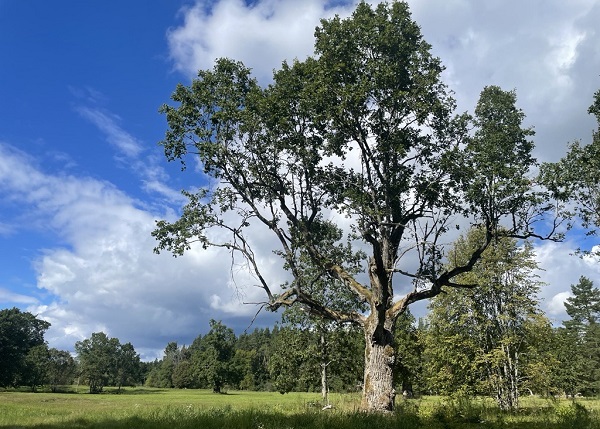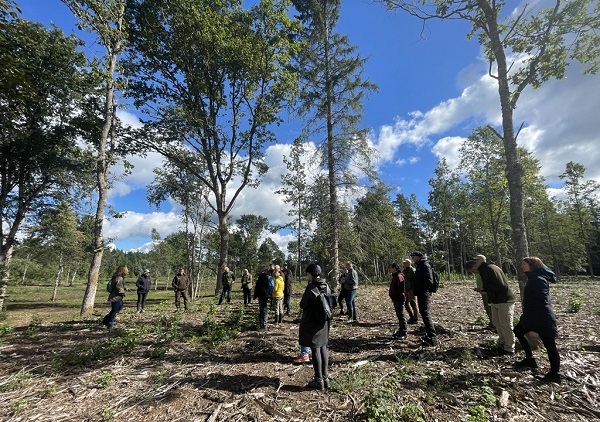LVM Presents the Restoration Works of Natural Meadows in Ziemeļgauja Protected Landscape Area
To introduce what has been done so far in the Natura 2000 territory, an exploratory walk was held on 2 September in the protected landscape area Ziemeļgauja, where JSC “Latvia's State Forests” (LVM) is restoring a rapidly disappearing habitat in Europe – park-like meadows and pastures – in a total area of almost 100 hectares. It was the first demonstration seminar within the framework of the LVM project. During this event, the participants walked through part of the area of restored lawns, where important biotechnical works were carried out, and listened to the experience shared by specialists on the various aspects of the implementation of complex works.
Currently, works have been carried out in Ziemeļgauja in an area of more than 60 hectares: the lawn has been cleared of overgrowth by cutting down trees and bushes, the cut vegetation and its remains have been collected and removed, the ground cover has been levelled and stumps have been milled to prevent the growth of woody plant shoots and to create better opportunities for the grass plant to recover from seed bases. A total of almost 100 hectares of park-like meadows will be restored within the framework of Ziemeļgauja park-like meadows project, which is the largest scale of park-like meadow restoration in Latvia. In the work area, significant work was also carried out to provide access roads and support infrastructure, so that the necessary equipment could access the areas of the planned works.
Ziemeļgauja is a Natura 2000 protected natural area of European Union significance; therefore, all biotechnical measures in the area were carried out with extra responsibility and approvals. When planning the trees and bushes to be cut down, biologically valuable younger and older trees that form the landscape and are important habitats for protected species are left intact. Some of the de-shaded biologically old trees of large dimensions, mainly oaks, are protected trees. Thus, by freeing biologically old oaks from overgrowth, the living conditions of a rare and protected species of beetle – the hermit beetle, which inhabits hollow trees illuminated by the sun, have been improved.
“In the course of the works, we also encountered a series of challenges based on the specifics of the work, which are not directly related to conventional forestry. The flooding characteristic of the habitat also posed a number of challenges – when the River Gauja overflowed during floods, the works to be carried out were limited or stopped, as it was impossible for forest equipment to move around, at the same time, the works had to be carried out at the specified time outside the bird nesting period. In turn, the relief characteristic of the Gauja floodplains had a significant impact on the large-scale stump milling works, which had to be carried out not only in flat, but also in relatively steep places,” says LVM Environmental Project Manager Ieva Rove.
Park-like meadows and pastures are a very rare biotope in Latvia – they occupy only 0.02% of the country's territory. Such meadows have particularly rich biological diversity and are an important element of the Latvian landscape. However, if meadows are not managed, they become overgrown with trees and shrubs. 100 years ago, the inhabitants of the Ziemeļgauja area used most of the territory for pastures; however, in the last 70 years, due to various circumstances, the meadows were no longer maintained and were almost completely taken over by the forest, creating unfavourable conditions for the species characteristic of the habitat living here and significantly changing the landscape.
“This project is directly aimed at preserving the diversity of species not only in forests, but also in other ecosystems, because, as is known, Latvia is rich not only in forests, but also in marshes and grasslands, and the involvement of the LVM is very valuable and the contribution made to grassland restoration is significant. One of the benefits that everyone will experience here in Ziemeļgauja will be a landscape characteristic of Latvia, they will be able to see these beautiful, old oak trees that were not visible before or had grown into the forest. Also, pollinators will be able to live and develop in the restored meadows, ensuring the function of pollinators in nearby farms as well,” says Andris Širovs, Deputy Director General of the Nature Protection Board in the field of nature protection.
Next year, LVM plan several more exploratory walks to introduce the completed works to improve the condition of species' habitats and biotopes in various areas; more information will be available on the LVM's website.
Ziemeļgauja is one of 14 specially protected natural areas, where LVM improves and restores habitats of EU importance until the end of 2023 within the framework of the European Union co-financed Cohesion Fund project “Management measures in specially protected natural areas and micro-reserves to improve the state of protection of habitats and species”.





